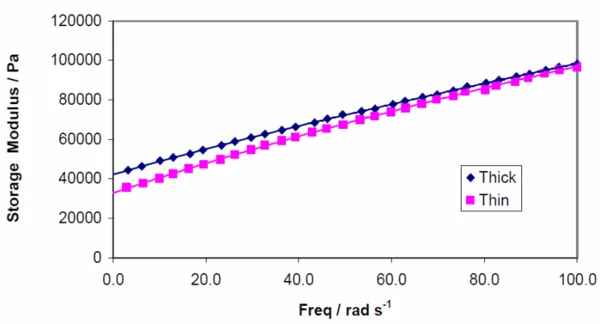
10.09.2021 by Milena Riedl, Dr. Shona Marsh
Solving Polymer Processing Problems Using a Kinexus Rotational Rheometer
Thermoplastic polymer melts are widely used in many modern industrial processes to manufacture a multitude of objects. Learn which properties measured with a Kinexus rotational rheometer help solve real-life polymer processing problems.
Thermoplastic polymer melts are widely used in many modern industrial processes to manufacture a multitude of objects. While the last article showed which properties of thermoplastics can be determined with a Kinexus Rotational Rheometer, we are now moving to real-life examples explaining how the measured properties can help solve polymer processing problems.
A) Variability of tube and pipe gauges in extrusion processes
Oscillatory testing at low frequencies revealed differences in the Elastic modulusThe complex modulus (elastic component), storage modulus, or G’, is the “real” part of the samples the overall complex modulus. This elastic component indicates the solid like, or in phase, response of the sample being measurement. elastic modulus between different batches of material. Clearly, the pipe gauge depends on the degree of recovery of the polymer after being extruded and so not surprisingly, the pipes and tubes with the higher gauge have a greater Elastic modulusThe complex modulus (elastic component), storage modulus, or G’, is the “real” part of the samples the overall complex modulus. This elastic component indicates the solid like, or in phase, response of the sample being measurement. elastic modulus.

B) Reducing Inconsistent Fiber Spinning Properties
By low-frequency oscillatory testing, differences in the elastic properties of different batches of material could be shown. The differences in elasticity at a low frequency are related to differences in the molecular weight distribution (MWD) with the result that the broader MWD results in increased molecular chain entanglement which hinders the draw down process of the fiber-spinning process. This, in turn, causes inconsistency in the final product.


In our next article, we will complete the picture on rheological analysis of thermoplastics and explain the properties that can be measured with the Rosand Capillary Rheometer.
Read also:
Diving into the Basics of the Rheology of Thermoplastics (ta-NETZSCH.com)
Analyzing Thermoplastics with a Kinexus Rotational Rheometer (ta-NETZSCH.com)
Source
[1] Rheology Testing of Polymers and the Determination of Properties Using Rotational Rheometers and Capillary Extrusion Rheometers (azom.com)
Thanks to Dr Bob Marsh (former employee of Malvern Panalytical) as the original author of this article!

FREE E-Book
Thermal Analysis and Rheology in Polymer Additive Manufacturing
Discover the secrets behind AM's game-changing capabilities! Our newly released ebook delves deep into the heart of AM, unveiling the power of reliable material characterization techniques, specifically thermal analysis and rheology.